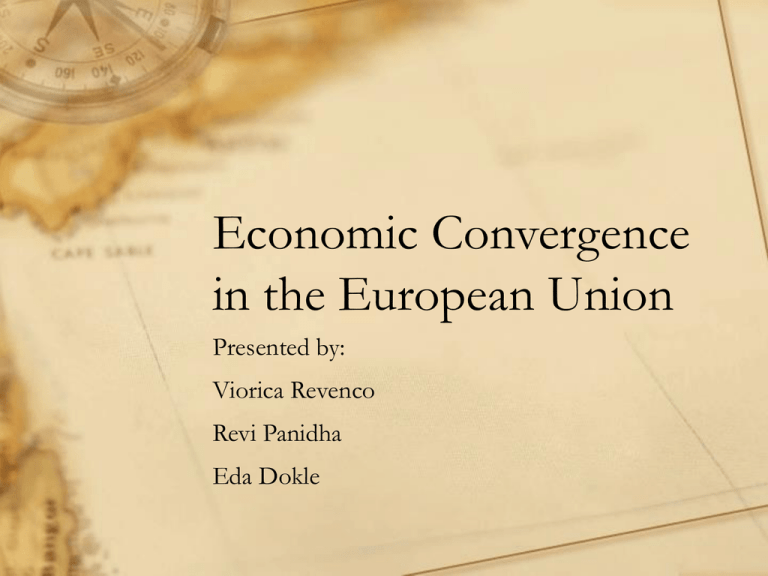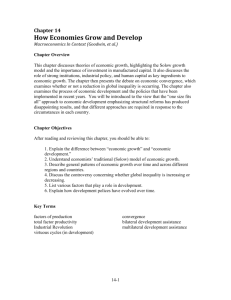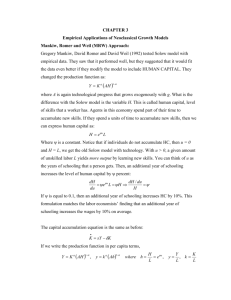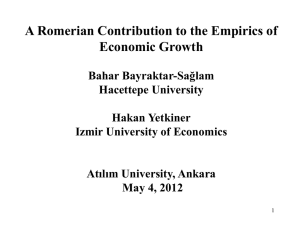economic convergence in EU
advertisement

Economic Convergence in the European Union Presented by: Viorica Revenco Revi Panidha Eda Dokle The Theoretical Economic Background of Convergence • What economic variable has the major role in convergence? • The Solow Model – theoretical framework of convergence • Economic convergence within EU – empirical evidence Growth Rate (i) • The causes of economic growth has occupied some of the best minds in the world of economics and commerce. • Robert Lucas and Growth Theory Nobel Prize winner remarked that once you start thinking about economic growth, it is hard to think of anything else. Growth Rate (ii) • Even a small change in a country’s growth rate can make an enormous difference in terms of living standards. Total Output & Sources of Growth • The output equation Y = AF (K, L) Y – total output; K – the economy’s use of capital; L – the economy’s use of labor; A – productivity. • The growth accounting equation ∆Y/Y = ∆A/A + aK ∆K/K + aL∆L /L ∆Y/Y – rate of output growth; ∆A/A – rate of productivity growth; ∆L /L – rate of labor growth; ∆K/K—rate of capital growth aK – elasticity of output with respect to capital; aL – elasticity of output with respect to labor. Sources of Growth • Productivity growth – the source of long-term growth (FDI, win-win situation) • Knowledge – replicable at a low cost, in contrast to capital and labor • Labor and capital are scarce and have an inherent Diminishing Marginal Returns feature that makes them a source of medium-term growth. The Solow Model (i) • A famous model of economic growth developed by the Nobel laureate Robert Solow in the late 1950’s • It attempts to address 3 major issues 1. Relationship between a nation’s growth and fundamental factors such as population growth rate, saving rate and rate of technical progress 2. Evolution of nation’s rate of economic growth 3. The convergence phenomenon The Solow Model (ii) k- Capital per worker y- Output per worker Solow Model - Conclusions • It supports the fact that in a group of countries with similar characteristics, the relatively poorer ones tend to grow faster than the relatively richer ones – convergence phenomenon • In support to this idea economic development of specific EU members is further analyzed Core-Periphery Model • Mega Core Countries France, Germany, Benelux, Austria, Finland, Sweden, UK and Northern Italy Capital Intensive • Periphery Countries Ireland, Greece, Spain, Portugal and Southern Italy Labor Intensive Ireland Before 1973 EC Accession • Economy strictly oriented and depended on British ties – 55% of exports to UK • Agricultural Output – one quarter of GDP Ireland – Economy in the EU Integration Context • Increased Trade and Decreased Dependence on UK • FDI • Funding via EC (EU) budget Ireland – Increased Trade and Decreased Dependence on UK • Exports to UK decreased to 18% in the first years following the accession • Exports to EU countries (excluding UK) increased to 43% in 2003 • Trade Deficit of €340 mil in 1973 • Trade Surplus of €34.7 bil in 2003 Ireland - FDI • Low Corporate Taxation of 10% => Increase in FDI • Ireland – GDP per Capita increase as % of EU Average Ireland – GDP per Capita Convergence to EU-15 Average Greece – Peculiar Case • EC membership in 1981 • Convergence Process starts in the mid 1990’s Greece – Economic Development • Greek Economic Miracle (1949-1975) – highest rates of growth in the world of 10% (following Japan ones) • Late 1970’s, 1980’s and mid 1990’s – decline in the rate of growth to 1.2% • 1996 – beginning of actual convergence Greece – Real GDP Growth Rate since 1996 Greece – Growth Peculiarity • Low levels of FDI – major capital controls • Community Support Framework (CSF) Program => CSF II (1994-1999) – EU transfers of 3.5-4% of annual GDP => 1-2% contribution to the rate of growth CSF III (2000-2006) – EU transfers of 3% of annual GDP => 0.7-1.2% contribution to the rate of growth CSF IV (2007-2013) – EU transfers of €20 bil => projected contribution of 0.6-0.8% to the rate of growth Greece – GDP per Capita (PPPDollar) Greece – GDP per Capita Growth Rate Greece –GDP per Capita Convergence towards EU-6 Germany – Slowdown in Pace of Growth • GDP growth rates: 1950’s – 8.2% 1960’s – 4.4% 1970’s – 2.8% 1980 – 2% 1991 (Unified Germany) – 1.3% Germany – Decrease in FDI Germany - Real GDP per Capita Convergence towards EU Average Convergence – Reality, but not a Pledge • Core periphery countries – upward tendency of GDP per capita to the EU average • Mega core countries – downward tendency of GDP per capita towards the EU average • Conditional upon the creation of a benefic economic environment – undertaking of effective macroeconomic and structural policies (Greece peculiarity) Thank you! Questions & Comments











